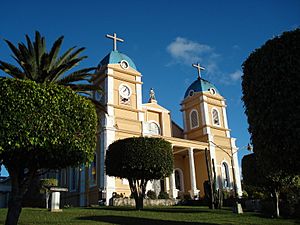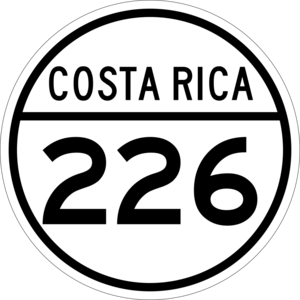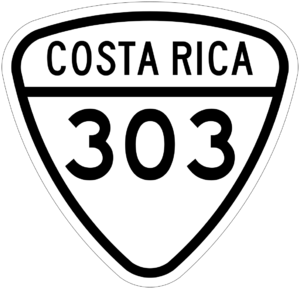San Marcos, Costa Rica facts for kids
Quick facts for kids
San Marcos
|
|
|---|---|
|
District
|
|

San Marcos de Tarrazu Roman Catholic church, Costa Rica
|
|
| Country | |
| Province | San José |
| Canton | Tarrazú |
| Creation | 3 August 1938 |
| Area | |
| • Total | 45.53 km2 (17.58 sq mi) |
| Elevation | 1,429 m (4,688 ft) |
| Population | |
| • Total | 9,993 |
| • Density | 219.48/km2 (568.45/sq mi) |
| Time zone | UTC−06:00 |
| Postal code |
10501
|
San Marcos is a district and the main city of the Tarrazú area in the San José Province of Costa Rica. It's a key part of the country, known for its beautiful landscapes and important crops.
Contents
History of San Marcos
The city of San Marcos was started in the 1820s. People who farmed moved there from the Central Valley. At first, they grew basic foods like beans, corn, and sugar cane.
Later, in the 1890s, local farmers began growing coffee in the mountain valleys. This region soon became famous for its really good coffee.
Geography of San Marcos
San Marcos covers an area of about 45.53 square kilometers. It sits at an average height of 1,429 meters above sea level.
The city is in a hilly area called Los Santos Zone. It's about 70 kilometers south of San José, the capital city.
San Marcos de Tarrazu is on the north side of the Pirris River. It's in a high valley surrounded by mountains. These mountains are part of the Talamanca Sierra in southern Costa Rica. Downtown San Marcos is 1,350 meters high. But some nearby mountain peaks reach up to 3,000 meters!
The land here is perfect for growing coffee. The mountain slopes face the morning sun, and clouds often cover the coffee trees in the afternoon. This protects them. The soil in the valley is red and comes from volcanic rock. All these things, plus the high altitude, create ideal conditions for growing the special coffee that farmers harvest here.
Economy and Coffee Farming
For a long time, the growth of San Marcos has been closely linked to its coffee industry. More recently, farmers have also started growing other crops like avocados. This helps them during years when coffee prices are low.
One reason this area has kept its coffee farms, while others in Costa Rica have struggled, is because of people moving away. Since the 1960s, many people from this region have moved to the United States for work.
Transportation in San Marcos
Roads in the District
The San Marcos district has these main roads:
- National Route 226
- National Route 303
Flora and Fauna of San Marcos
The San Lorenzo district, which is part of this area, was often overlooked by coffee farmers. This is because it has lower lands and a tropical climate. However, tourism has recently become popular here. People love its untouched forests and clean rivers. It's also close to the Quepos plains and Manuel Antonio National Park.
You can find huge, ancient ferns and large hardwood trees here. Birds like the Quetzal and many small mammals live in this area.
Population of San Marcos
| Historical population | |||
|---|---|---|---|
| Census | Pop. | %± | |
| 1883 | 552 | — | |
| 1892 | 815 | 47.6% | |
| 1927 | 1,639 | 101.1% | |
| 1950 | 1,900 | 15.9% | |
| 1963 | 2,546 | 34.0% | |
| 1973 | 3,838 | 50.7% | |
| 1984 | 5,381 | 40.2% | |
| 2000 | 8,240 | 53.1% | |
| 2011 | 9,993 | 21.3% | |
|
Instituto Nacional de Estadística y Censos |
|||
In the 2011 census, San Marcos had 9,993 people living there.
Most people in San Marcos grow coffee in the mountains around the city. San Marcos de Tarrazú is well-known in the coffee world for its coffee beans. Nearby towns like Santa Maria and San Pablo also produce special coffee beans. About 90% of the people here are Roman Catholic. Many people from Nicaraguans and Panamanian Native Americans have been moving to the valley to help pick coffee.
Culture of San Marcos
The local culture in San Marcos is similar to the rest of Costa Rica. The Catholic Church and the government both play a big role in deciding when holidays and celebrations happen. For example, the yearly Patron Saints' Day Festival is both a community and a religious event.
While the importance of coffee farming has gone down in some parts of Costa Rica, this region is still very connected to it. You can see this because many children in the area still help pick coffee. This is a tradition that has mostly stopped in the Central Valley, where foreign workers, especially from Nicaragua, do almost all the coffee picking.
Notable People from San Marcos
- Maria Eugenia Bozzoli (born 1935), an expert in studying human cultures.
Images for kids
See also
 In Spanish: San Marcos de Tarrazú para niños
In Spanish: San Marcos de Tarrazú para niños









